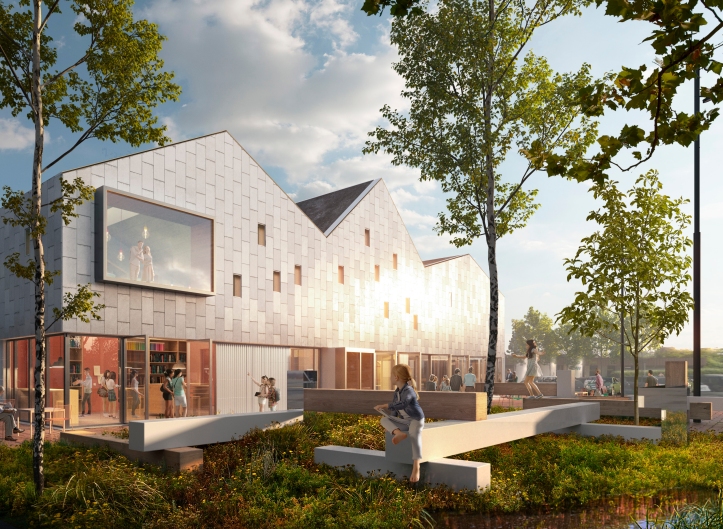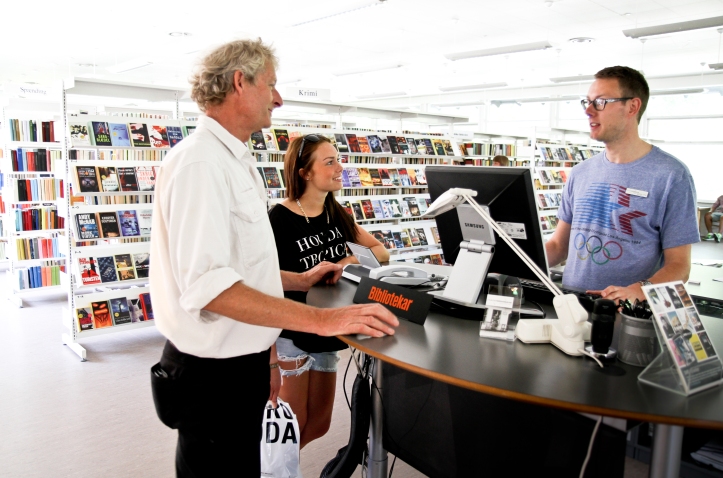
In the beginning of the year Rolf Hapel, former director of libraries and citizen services in Aarhus, Denmark, now Professor of Practice at the Information School in Washington DC, sent me an email. He had been asked to write some perspectives on the public library in 2030 for a compilation and asked if I would chip in with some perspectives from the Danish library landscape. Sure I would so I sent Rolf 5 trends that I see as being important in years to come. In return Rolf sent me reflections on the very same trends from his perspective on the public library field in USA and as many times before, asking great questions and exchanging ideas and perspectives resulted in new thoughts and reflections.
So we decided to share the email conversation in a blog post – enjoy and we hope you will join the conversation.
The library are merging with other institutions
Christian: The library as a building and institution more frequently becomes a part of a collective with other institutions and parties; Citizens Services, Culture Centers, Music Schools, Tourist Offices etc. are often the names of the other residents in the building. This is a trend that has been going on for some years and are very much a part of the library landscape in Denmark and it only seems to increase in the coming years. The degree of motivation and collaboration on the other hand varies a lot. One take is that the different institutions are just residents in the same building, no collaboration is organized and the moving in together is driven by municipality budget cuts. Another take is to proactive harvest the benefits of collaboration and synergy by living in the same house and use that to make great stuff for the community. We have a great example in the town of Viby were we currently are building a new house for library, citizen services, culture center and local archive. Especially the partnership with the local culture center, KulturCosmos, I’m thrilled about – it’s municipality that meets civil society with the ambition and shared goal to making a stronger community in close collaboration and I think we will develop the libraries role and impact in the local community. I’ve written a little bit about it in the blog post: Building the library of tomorrow – bridging municipality and civic life to create a community living room
Rolf: It hasn’t happened to the same degree in US as in Denmark. The library is very much a ‘distinct’ institution still but it’s noticeable that many libraries collaborate in bigger consortiums and systems that creates benefits and scale. A wave of what is called “collective impact” is also getting a larger grip; It’s about structured collaboration with other institutions within culture and especially the social field that aims at getting a larger impact on local community problems. Formal or informal collaborations with various parties in the local community is also becoming increasingly common.

In a digital age the physical meeting doesn’t become less significant
Christian: Libraries are about people and people are social animals that needs contact with other human beings. We need to feel that we belong to something. That is how is has always been and probably always will be. I embrace the digital development in all it facets but I experience that the more social digital platforms we get the higher is the need for share public places where we can meet, connect, learn, get challenged, laugh, cry and simply just feel that we belong and that we have a place in the community. Successful urban planning doesn’t rely on how many square meters you can create for staying but how many square meters you can create for living; Parks, sports facilities, community centers, libraries and even bars. “First life, then spaces, then buildings” as iconic urban planner Jan Gehl ones said. The library must develop and position itself as a highly relevant institution when it comes to supporting a strong social infrastructure.
Rolf: To a high degree the same trend in USA. What Eric Klinenberg in his Palaces for the People calls ‘social infrastructure’ – physical public free places for people to meet and connect – are recognized as important and libraries plays an important role in creating such places. In a society that struggles with high levels of inequality and social obstacles such places cannot be underestimated. And where Denmark has a strong digital infrastructure meaning that almost everybody has access to the internet through powerful broadband, America struggles with this too. I’ve just interviewed the director of libraries in a county in a very rural part of US with 45.000 citizens of which only 1/3 has access to the internet from home. Even young parents hasn’t access to internet and are lacking asic digital literacy skills that is needed to help their kids with homework so in those cases you can be expecting second generation of ‘tech illiterates’. This highlights the library as an important gateway for internet access, which is a thing we have left behind in Denmark some time ago.

The collection will still be a core task and is what distinguish the library from other institutions
Christian: I find the collection of the library to be significant both now and in the future. By ‘collection’ I don’t just mean a single library’s local collection but the ability to connect every single human being in the world with relevant knowledge, information and data through the library – also to resources outside the traditional library collection. The collection and the skills that the library staff put into organizing knowledge, find information and teach the community information literacy is also what separates the library from other institutions. In Denmark we have many Culture Centers and Community Organizations that have similar aims as the library when it comes to foster stronger communities through shares places and cultural activity. The past years sometimes panic-like discussions within library circles about the libraries future and legitimization has pushed the focus on the collection in the background but to me this is where one of the very strong answers for the past, present and future of libraries lies; How do we actually support life-long learning, democracy and fight inequality and polarization? Very much through the collection and that core librarianship that is connected with organizing knowledge, information seeking and being source critical and by teaching those tools to the community. We should continue to acknowledge the importance of this and develop it and communicate the importance of it to decisions makers and communities.
Rolf: Much more than in Denmark the US libraries are focused on the collection but there are also a very strong tradition for doing programs and events. Since 2012 the lending numbers has been decreasing steady while the program activities has been increasing which had made the American Library Association launch a huge research project called National Impact of Library Programs Assessment. which aims at documenting impacts and outcomes of libraries program activities. I agree that the collection is unique for libraries while our core values are something that we share with other institutions of culture. I like David Lankes’ definition of the purpose of librarianship from his Atlas of New Librarianship: “The Mission of Librarians is to Improve Society Through Facilitating Knowledge Creation in Their Communities” – a constructivist and activist approach that isn’t just build up around the collection but is oriented towards cognitivism styles of learning and opens up towards more formats and approaches.
The need to talk about the value of the library in new ways
Christian: Library Denmark goes a little bit nuts every year when the annual library statistics are released. Lending numbers, downloads and foot traffic attends an extremely degree of attention from library professionals, media and decision makers. Those statistics are for sure important and over years they say something about the use of libraries. But they far from cover the whole picture when it comes to the impact and value that libraries create in communities. The numbers don’t show us how libraries connect people and foster social infrastructure. They don’t show how meeting professional library staff can make a difference in people’s life. They do not outline how attending library programs supports life-long learning or if communities with libraries have a lower degree of loneliness than communities without. In the coming years Danish libraries and library organizations has to crack this in order to give ourselves, decisions makers, media and communities some tools and figures to actually talk about the value and impact libraries have on communities.
Rolf: On this matter the libraries in the US are far ahead of Denmark and we can learn a lot about advocacy, impact assessment, outcome, evidence-based performance indicators, narratives and storytelling. Those are just some of the ways library managers work to highlight the social significance of the library. ALA has an office with, as far as I remember, 14 employees who work exclusively professionally with advocacy on behalf of libraries. Another important support of library impact and staff training is called WebJunction (OCLC’s Distance Learning Unit located in Seattle) and has a great offer of webinars, tutorials and courses, some of which are aimed at advocacy and outcome measurement.

National development and local anchoring
Christian: The library landscape in Denmark is very different when it comes to municipalities. There is a huge difference on the municipality focus, demographics, size, economic scales and library systems in such places as Roskilde, Lolland and Aarhus. It is a no-brainer but I find it extremely important to hold on to the idea, that libraries creates value by focusing on the local community and the challenges in which the library could be the answer. And there is a huge difference between the challenges you face in Roskilde. Lolland and Aarhus and by that focus for the local library systems has to be difference. It has to be that way if we effectively wants to make a difference. I think most of my colleagues in Denmark agree in this and to succeed nationally as well as locally it is crucial that we make a strong connection between the national (and international) library development and the local work and focus in the municipalities. We need to create national development that can be scaled to Roskilde, Lolland, Aarhus and the rest of the country.
Rolf: A theme that is even more topical over here. Of the 16.500 public libraries in the United States, 2/3 are in rural communities – and both cultural differences and distinctions in value sets are sometimes incomprehensibly large from fly-over states to coastal cities, from the northern plains to the southern desert states, and cultural and identity differences are striking large between ethnic and racial groupings. There is, as far as I can tell, a clear evolution towards much stronger group identities, some would say tribalism, individuals build identities in ways that were previously unknown. Exciting and challenging – also for the libraries.
Does the above trends apply to your country? Do you see other things that will affect the public library towards 2030? We love to hear from you so join in in the comments, on social media or mail us
Cheers

[…] https://christianlauersen.net/2020/02/18/5-things-that-will-affect-the-public-library-towards-2030/ […]
LikeLike
[…] 1. 5 things that will affect The Public Library towards 2030 […]
LikeLike